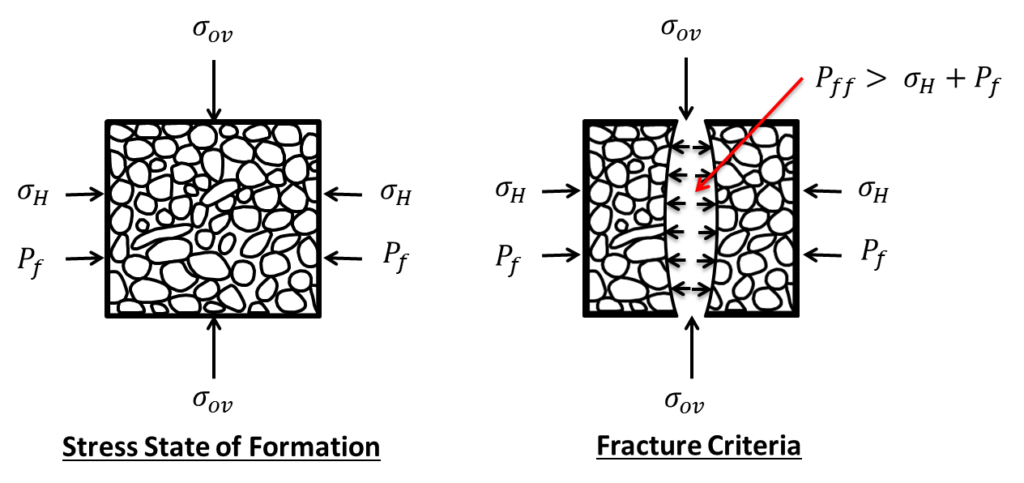Previously, we applied solid mechanics to determine the stress condition on a rock in the horizontal direction. So how does knowing the stress on a rock tell us how the formation will fracture?? Once again we have to go back to solid mechanics. Remember this statement: The fracture will orient itself perpendicular to the MINIMUM principal stress. If your struggling to understand what this means, please reference the figure below and then I think you will get it:

The rock is expected to fracture vertically. Why? Because the total horizontal stress in most cases is the least principal stress i.e. (![]() ). Of course a horizontal fracture will occur if the total vertical stress is less than the total horizontal stress. However it is very uncommon. Occasionally horizontal fractures will occur in shallow formations (< 1500 ft), however not a lot of wells are drilled at shallow depths so it’s of minor importance. If your still struggling with this concept, imagine yourself in the dead center of a rock element trying to escape its interior. Push in all directions. Which direction is it easiest to push the rock open? Which way will it open so you can get out? If you answer these questions correctly, you will see why a rock fractures perpendicular to the least principal stress.
). Of course a horizontal fracture will occur if the total vertical stress is less than the total horizontal stress. However it is very uncommon. Occasionally horizontal fractures will occur in shallow formations (< 1500 ft), however not a lot of wells are drilled at shallow depths so it’s of minor importance. If your still struggling with this concept, imagine yourself in the dead center of a rock element trying to escape its interior. Push in all directions. Which direction is it easiest to push the rock open? Which way will it open so you can get out? If you answer these questions correctly, you will see why a rock fractures perpendicular to the least principal stress.
So how do we predict the fracture pressure? It should be straightforward now that we know how to calculate pore pressure, overburden stress, effective stress, and horizontal stress. The stress state of the formation and the fracture criteria is shown in the figure below:

Looking at a rock element, the total vertical stress is simply the overburden stress, i.e. ![]() . Remember
. Remember ![]() , so it does include the pore pressure term. The total horizontal stress on the element is the sum of the horizontal stresses and pore pressure, i.e.
, so it does include the pore pressure term. The total horizontal stress on the element is the sum of the horizontal stresses and pore pressure, i.e. ![]() . The rock will fracture in the vertical direction if the fracture pressure (
. The rock will fracture in the vertical direction if the fracture pressure (![]() ) is greater than the total horizontal stress. This criteria is represented by the following expression:
) is greater than the total horizontal stress. This criteria is represented by the following expression:
(1) ![]()
We have accomplished what we set out to do and that is apply fundamental concepts to calculate a fracture pressure. Of course there are more complicated fracture equations and empirical equations used to predict fracture pressure. However what was presented here was the most fundamental form on how to calculate fracture pressure of a formation. Just understanding these concepts will make the harder concepts easier to understand as you start your career.